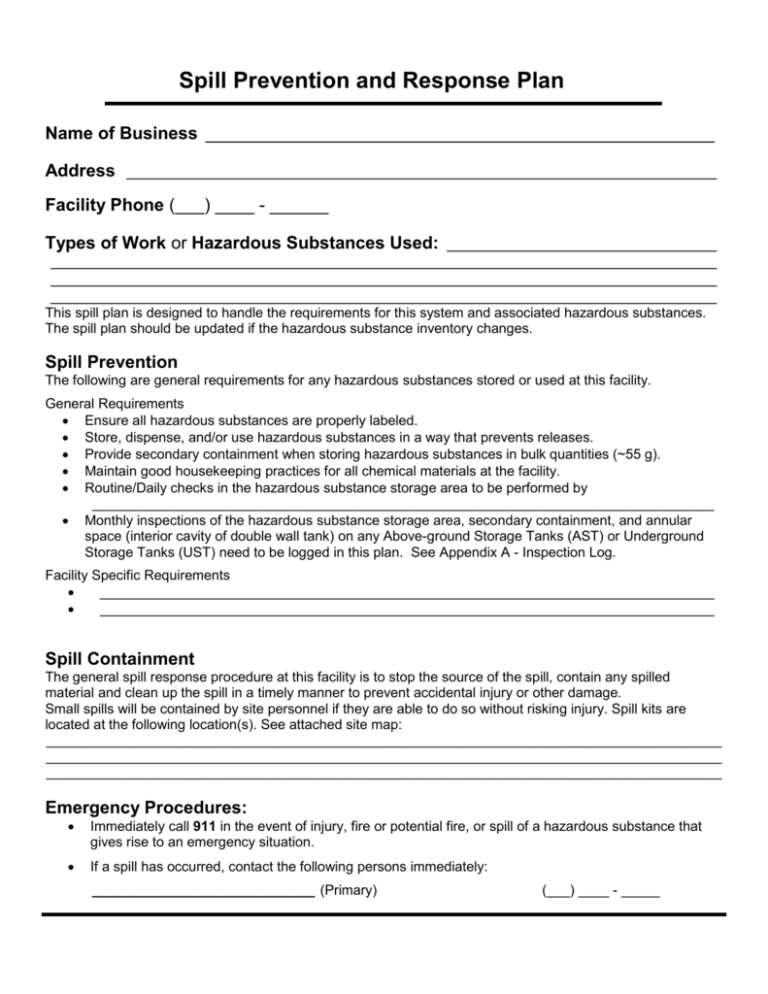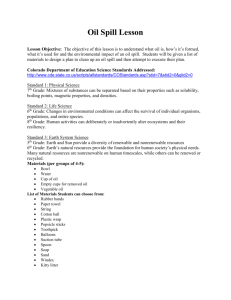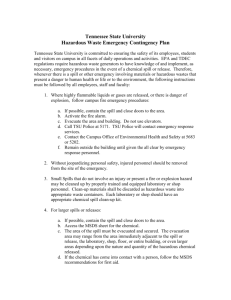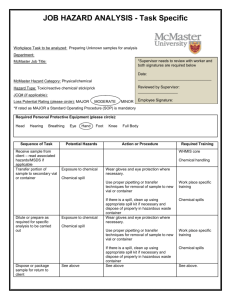Spill Prevention & Response Plan (Template)
advertisement

Spill Prevention and Response Plan Name of Business ____________________________________________________ Address ______________________________________________________________________ Facility Phone (___) ____ - ______ Types of Work or Hazardous Substances Used: ________________________________ _______________________________________________________________________________ _______________________________________________________________________________ _______________________________________________________________________________ This spill plan is designed to handle the requirements for this system and associated hazardous substances. The spill plan should be updated if the hazardous substance inventory changes. Spill Prevention The following are general requirements for any hazardous substances stored or used at this facility. General Requirements Ensure all hazardous substances are properly labeled. Store, dispense, and/or use hazardous substances in a way that prevents releases. Provide secondary containment when storing hazardous substances in bulk quantities (~55 g). Maintain good housekeeping practices for all chemical materials at the facility. Routine/Daily checks in the hazardous substance storage area to be performed by _________________________________________________________________________________ Monthly inspections of the hazardous substance storage area, secondary containment, and annular space (interior cavity of double wall tank) on any Above-ground Storage Tanks (AST) or Underground Storage Tanks (UST) need to be logged in this plan. See Appendix A - Inspection Log. Facility Specific Requirements ________________________________________________________________________________ ________________________________________________________________________________ Spill Containment The general spill response procedure at this facility is to stop the source of the spill, contain any spilled material and clean up the spill in a timely manner to prevent accidental injury or other damage. Small spills will be contained by site personnel if they are able to do so without risking injury. Spill kits are located at the following location(s). See attached site map: ________________________________________________________________________________________ ________________________________________________________________________________________ ________________________________________________________________________________________ Emergency Procedures: Immediately call 911 in the event of injury, fire or potential fire, or spill of a hazardous substance that gives rise to an emergency situation. If a spill has occurred, contact the following persons immediately: _____________________________ (Primary) (___) ____ - _____ Spill Prevention and Response Plan _____________________________ (Secondary) (___) ____ - _____ _____________________________ (After Hours Emergency Contact) (___) ____ - _____ In the event of a large spill, a properly trained employee should: Assess the area for any immediate dangers to health or safety (i.e. a wrecked car on fire). If any dangers are present, move away from the area, call 911. Notify the primary and/or secondary contact from the list above and then continue your spill response. The primary contact should assess additional notification requirements. Retrieve the spill kit from the closest location. Assess the size of the leak and any immediate threat of the spill reaching the floor/storm drains or permeable surfaces in the area. If there is an immediate threat and there are no safety concerns, then attempt to block the spill from coming in contact with the floor/storm drain or permeable surface. If no drain covers are available, then try to use absorbent (cat litter) and/or sock booms or rags to stop the spill from getting into the drains or to any permeable surfaces. If the spill can be contained with absorbent booms, deploy them around the spill. Use the booms to direct the spill away from any immediate hazards (i.e. a wrecked car). If there is no immediate threat to the floor/storm drains or permeable surfaces, or after controlling the spill, try to plug or stop the leak, if possible. If applicable, put on protective gear (gloves, goggles, protective clothing, etc.) and plug the leak. Once the spill has been contained and any immediate threat to storm drains or permeable surfaces has been minimized, contact the spill cleanup contractor and dispatch them to clean up the spill or commence spill cleanup procedures. Spill cleanup for large spills should be handled by the Spill Cleanup Contractor Company Name __________________________ 24-Hour Phone (___) ____ - _____ Spill Reporting If a hazardous substance spill exceeds 25 gallons or if any amount has been released to soil, surface water, or storm drains, notify the following agencies: National Response Center (NRC) (800) 424-8802 Florida State Warning Point (SWP) (800) 320-0519 Spill Prevention and Response Plan Hazardous Substance Inventory Hazardous Substance Major Groups Only Manufacturer Quantity/Unit of Issue Spill Prevention and Response Plan Plan Management The primary contact or designee shall administer this plan and will be responsible for updating and including any required documentation. Training All personnel who may respond to any spill, need to be trained on the contents and procedures in this plan. Trained personnel will add their names and dates of training to the Training Log (see Appendix D). Only persons trained on this plan shall respond to a spill. If you are not trained and witness a spill, call or notify the primary and secondary contacts listed on Page 2 of this plan. Spill Tracking Any spills must be entered into the Spill Log (see Appendix C). If a large catastrophic spill occurs, attach additional pages to describe the event. Include known or possible causes, areas affected, and effectiveness of the cleanup. Include a review of the cleanup contractor and their procedures. For small spills, it is sufficient to fill out the Spill Log, and to take measures to prevent a repeat occurrence. Facility Inspections Routine inspections will be conducted daily during regular business hours. Daily inspections will include, at a minimum, a visual inspection of the hazardous substances containers and the area immediately adjacent to it for signs of a spill or leak. These inspections do not need to be logged unless a spill or leak is detected. Ideally, these inspections will be conducted by a manager or by regular employees. Full site inspections will be conducted monthly by the primary contact or designee and, at a minimum, will include those items on the inspection form in Appendix B. If any item on the inspection form is found unacceptable, the inspection form will be attached to this plan. If all items are deemed acceptable; it is sufficient for the inspector to log only the inspection and the results in the Inspection Log (Appendix A). Disclaimer This spill plan is designed to be applicable to a broad number of business types and hazardous substance handling and storage situations. Modifying this plan to reflect your site specific hazards and business practices is highly recommended. Your facility assumes all responsibility for the contents of this Spill Management Plan and the use of this plan within the business. Spill Prevention and Response Plan Appendix A - Inspection Log A = Acceptable U = Unacceptable Inspection Year Inspector Month Initials January February March April May June July August September October November December January February March April May June July August September October November December January February March April May June July August September October November December Lids and Labels? If any items are unacceptable attach Inspection Form with details. Evidence Alarms New Spill Kit Storm Items Of Spills? or Product? Complete? Drains? Fixed? Sensor? Spill Prevention and Response Plan Appendix B Inspection Form Acceptable Unacceptable Lids and Labels? Have all lids and caps been returned to their proper place? Do all the containers still have labels? Evidence of Spills? Is there any indication that a spill might have occurred? If so, was the spill properly cleaned up? Was there any spill kit materials used? Was the Spill Log filled out for that incident? Any housekeeping issues? For Tanks with alarm systems only Any Alarms or Sensor issues? Have there been any alarm conditions in the past month? If alarms have occurred, has the monitoring system been serviced by the manufacturer or an authorized service company? Is the system up and working at this time? Is the sensor working? Did you conduct a test of the alarm and the sensor? When was the last time the sensor was serviced? New Hazardous Substances? Have any new chemical products been purchased? Do you have the MSDS for new products? Have you assessed how to store and handle this new product safely? Have you added the new hazardous substance to the inventory sheet in this plan? Is the container properly labeled? Spill Kit Complete? Have any items been used from the spill kit? If items are missing, is there an associated entry in the Spill Log? Are there any items missing that are currently on order? Is the spill kit stored where it is supposed to be stored? Is there a sufficient supply of daily cleanup materials? Storm Drains? Is there a buildup of sediment in the drain traps? Is there any evidence of drain clogging? Are the drain filters still intact? Any need replacing? Have they been replaced? Items Fixed? Have all deficiencies previously noted been fixed or made acceptable? List any issues, deficiencies, or failures in detail: ____________________________________________________________________ ____________________________________________________________________ ____________________________________________________________________ ____________________________________________________________________ Spill Prevention and Response Plan Appendix C – Spill Log Date of Spill Location of Spill Size of Spill (~ gal) Prevention Measures Taken? Spill Kit Materials Reordered? Was the Spill Kit Adequate? (List any deficiencies, i.e. missing equipment, etc.) Spill Prevention and Response Plan Appendix D – Training Log Employee’s Printed Name Signature Date Completed Spill Prevention and Response Plan Site Map Note locations of spill kits, inside floor drains, storm drains, and hazardous substance storage areas.








